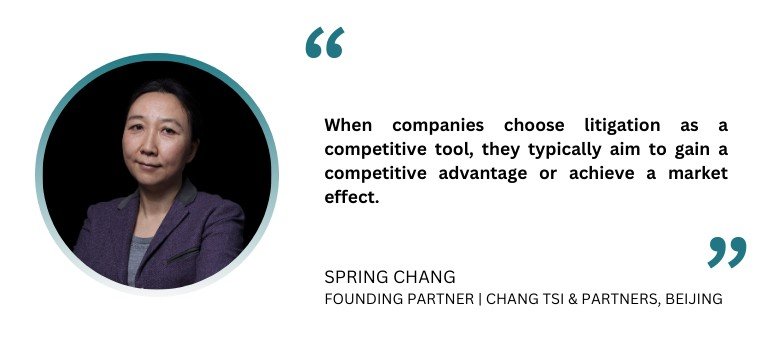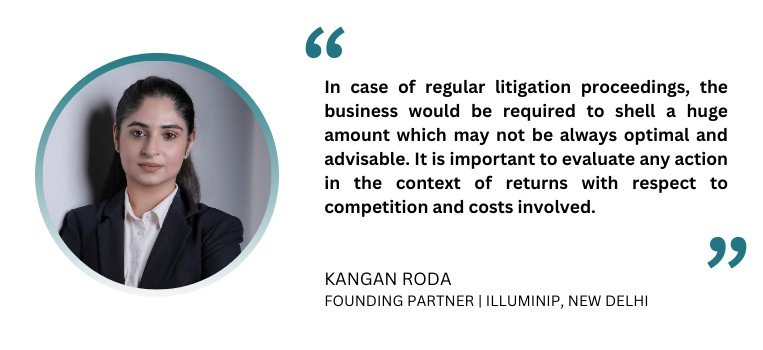Businesses should also consider the effects of IP litigation on innovation. “Overly aggressive litigation can stifle innovation if parties become exaggeratingly cautious about potential IP conflicts. Hence, as IP lawyers, it is incumbent upon us to fully explain to our clients the advantages and disadvantages of IP litigation,” said Ilas-Panganiban.
Using litigation as a competitive tool may also complicate the market environment and structure. These may affect the business itself. Chang explained: “Frequent litigation can lead to strained relationships between companies and their competitors, even disrupting the cooperative atmosphere within the industry. Such tension may also affect a company’s reputation within the industry and its future collaboration opportunities while increasing market uncertainty and impacting investor and consumer confidence. Additionally, competitors may fight back, leading to prolonged legal battles or seeking new competitive strategies or market opportunities, thereby altering the market landscape. For example, many well-known companies have been engaged in patent litigation for years, which not only affects the competitive dynamics of the relevant markets but also makes other companies more cautious in designing and developing new products to avoid similar legal disputes.”
How to best use litigation for your competitive advantage
Considering these downsides, how can businesses and lawyers best leverage litigation as a competitive tool to gain an advantage over the other party in the dispute and over the competition in general?
Aside from seeking injunctive relief, damages and others, the following are critical steps that companies and their lawyers should take:
Formulate a comprehensive IP strategy. Such strategy should include litigation. “IP is one of the spaces which is still rapidly developing worldwide, and as such, it becomes important to keep oneself updated on the case laws and the evolving jurisprudence,” Roda explained.
Get your IP rights registered as soon as possible, properly document the evidence to prove the existence of IP rights and implement protection mechanisms for other IP rights such as trade secrets. According to Dinh, these are the first steps toward any successful litigation case. “Once the ‘arsenal of IP rights’ is ready, gathering evidence of the infringement and making sure that the evidence is preserved legitimately to be valid before the court are equally important to the registration,” he said.
Before deciding on litigation as a business strategy, thoroughly assess your litigation goals and potential outcomes. In case of adverse outcomes, lawyers should consider the risk appetite and commercial interests of their clients. Analyze industry dynamics and competitor situations. Understand the other party in the litigation case by looking into their scope of business, the level of the infringement and local enforcement practices.
“There is a fundamental difference between using litigation as a legitimate competitive tool and exploiting it for improper gains,” said Chang. “The market encourages fair competition, and litigation is a right of enterprises, but it is essential to avoid falling into the category of malicious litigation. This requires companies to thoroughly evaluate the specific circumstances when considering litigation as a competitive tool.”
Strategically time your actions. “Indicators that may assist the best time to proceed include such time as when you see growth, steady or abrupt, in the business of the competition or launch of IPO or any investments into the said competition. Initiation of your actions or proceedings at such times would be optimal and would yield the most positive and effective results,” said Roda.
Be aware of the potential weaknesses and obstacles that might turn the case against you and prepare for these in advance. Lawyers should serve as efficient watchtowers for their clients, giving them the go signal whether to pursue or pause litigation, negotiate and discuss, or retract.
Update your strategies. “During the litigation process, it is essential to update strategies based on actual circumstances, such as engaging in settlement negotiations to quickly achieve business objectives and avoid the uncertainties and costs associated with prolonged litigation,” explained Chang.
Lawyers and their clients must closely strategize, not just in terms of how to go about the actual case but also how to manage public perception through effective communication. This will help enhance the client’s reputation as a strong defender of its IP assets.
Review and update your IP to ensure its validity and strategic alignment. “Clients should be prepared to proceed with litigation to enforce their IP rights and advance their business but should actively consider settlement and mediation to resolve the dispute and achieve an acceptable resolution for their business,” Yang noted.
According to Dinh, IP litigation proceedings vary among jurisdictions and this isn’t always a comfortable experience. International collaboration is now underway to simplify the proceedings and further enhance the role of IP litigation.
In the case of Vietnam, the government has now adopted the establishment of a specialized IP court. “Accordingly, it shows the progressive attitude of the government in promoting a strong, swift and effective IP litigation system, which is vital to the development and growth of the business market and innovation in a developing country like Vietnam,” Dinh said.
There are other strategies for protecting and leveraging IP. Among these are licensing agreements and collaborative partnerships. For Ilas-Panganiban, it is crucial to balance the use of IP litigation as a competitive tool with these other strategies.
“Based on our firm’s experience, IP litigation is not always the best solution to protect and enforce IP rights,” she revealed. “Nevertheless, IP litigation can be a powerful competitive tool because it demonstrates the capacity and solid determination of the IP owner to fully exercise its exclusive rights over the IP.”
And, as long as it is used judiciously, litigation certainly helps businesses gain a competitive edge or strengthen their foothold in the market and promotes a positive business environment for the jurisdiction.












